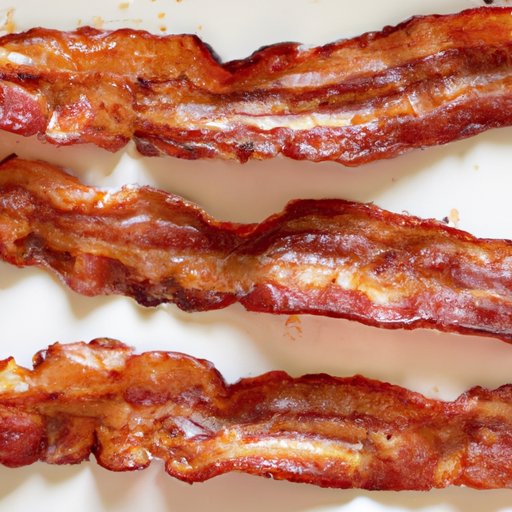Introduction
Crispy bacon is a beloved breakfast staple, but cooking it on the stovetop can be a messy and time-consuming process. Luckily, there’s a better way: baking bacon in the oven. Not only is it less messy, but it also yields perfectly crispy strips every time. This article will provide a step-by-step guide to baking perfectly crispy bacon in the oven while avoiding common mistakes, and share the benefits of baking bacon and some easy bacon recipes.
Step-by-Step Guide: How to Bake Perfectly Crispy Bacon in the Oven
To bake bacon in the oven, follow these simple steps:
Ingredients and tools needed:
- Bacon
- Baking sheet
- Aluminum foil
- Tongs
Preparing the bacon strips:
- Line the baking sheet with aluminum foil for easy cleanup.
- Place the bacon strips on the sheet, making sure they don’t overlap.
Setting the temperature and time:
- Preheat the oven to 400°F.
- Bake the bacon for 10-12 minutes, depending on the thickness of the strips.
Checking for doneness and adjusting the time if needed:
Check the bacon every 2-3 minutes after the first 10 minutes to make sure it doesn’t burn. Once it reaches your desired level of crispiness, take it out of the oven with tongs.
Removing the bacon from the oven:
- Place the bacon strips on a paper towel-lined plate to absorb the excess fat.
- Use the tongs to transfer the bacon to a serving dish or your plate.
Tips for cleaning up:
Let the remaining fat cool and solidify before disposing of the aluminum foil. This makes it easier to clean and prevents the fat from clogging your pipes.
The Best Way to Bake Bacon: Tips and Tricks from a Professional Chef
Here are some tips and tricks to take your baked bacon to the next level:
- Use a wire rack or parchment paper to elevate the bacon strips and allow for even cooking.
- Try adding seasonings or glazes like brown sugar or maple syrup for extra flavor.
- Don’t throw away the bacon grease! You can use it for cooking other dishes, like frying eggs or baking savory pastries.
- Store leftover bacon in an airtight container in the fridge for up to four days, and reheat it in the oven at 350°F for a quick and easy breakfast.
Bake Your Bacon to Perfection: Top 5 Mistakes to Avoid
Here are five common mistakes to avoid when baking bacon:
- Don’t overcrowd the baking sheet. Leave some space between the bacon strips for even cooking.
- Start with a preheated oven. Putting your bacon in a cold oven will result in uneven cooking and chewy strips.
- Don’t overlap the bacon slices, as this will cause them to stick together and cook unevenly.
- Don’t bake the bacon at high heat, as this can cause it to burn and dry out.
- Don’t leave the bacon in the oven for too long, as it will continue to cook and can become too crispy or burnt.
10 Delicious Bacon Recipes You Can Make Using Your Oven
You can use baked bacon in a variety of dishes. Here are ten delicious bacon recipes to try:
- Bacon-wrapped asparagus
- Bacon-wrapped dates
- Bacon-wrapped chicken tenders
- Bacon and egg cups
- Bacon-wrapped jalapeno poppers
- Bacon-wrapped pork tenderloin
- Bacon mac and cheese
- Bacon-wrapped shrimp
- Bacon-wrapped Brussels sprouts
- BLT salad
Why Baking is the Healthiest Way to Cook Bacon and How to Do it Right
Baking bacon is a healthier alternative to frying it on the stovetop. Here’s why:
- Baking bacon allows the excess fat to drip off, reducing the overall fat content.
- It also reduces the formation of harmful compounds like carcinogens that can occur during frying.
- However, it’s important to note that bacon is still high in calories and should be consumed in moderation.
To further minimize the harmful effects of bacon, remove it from the oven once it reaches your desired level of crispiness, and avoid charring it.

The Science of Baked Bacon: How to Get Perfectly Cooked Strips Every Time
The Maillard reaction is responsible for the delicious color and flavor of bacon. It occurs when amino acids and sugars in the bacon react to the heat. To get perfectly cooked strips every time, follow these guidelines:
- Cook bacon at a temperature between 350°F and 400°F to allow the Maillard reaction to take place without burning.
- Bake the bacon for 10-12 minutes, depending on the thickness of the strips.
- Thick-cut bacon will take longer to cook than thin-cut bacon.
Quick and Easy Bacon Baking Hacks for Busy Mornings
If you’re short on time in the morning, these bacon baking hacks will help you make the most of your time:
- Prep your bacon the night before by lining the baking sheet with aluminum foil and placing the bacon strips on it. Cover the sheet with plastic wrap and refrigerate it overnight. When you wake up, preheat the oven and bake the bacon as usual.
- Use the aluminum foil to create a makeshift bowl to collect bacon grease. Once the grease cools and solidifies, you can simply lift out the foil and dispose of it.
- Make bacon bits by chopping up cooked bacon and storing it in the fridge for future use in salads, pasta dishes, or omelets.
- Store leftover bacon grease in a jar and use it for cooking or baking later on.
Conclusion
Baking bacon is an easy and less messy way to achieve perfectly crispy strips every time. By following the step-by-step guide and avoiding common mistakes, you can bake bacon like a pro. Experiment with different seasonings and glazes, and try incorporating baked bacon into your favorite dishes. Not only is it delicious, but it’s a healthier alternative to frying.
